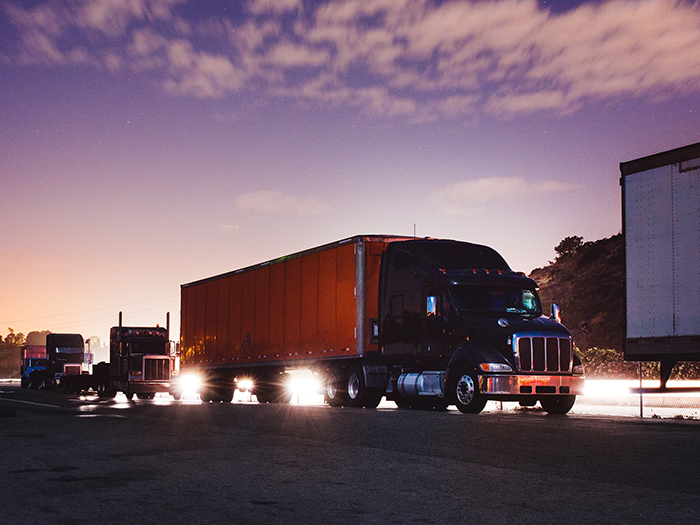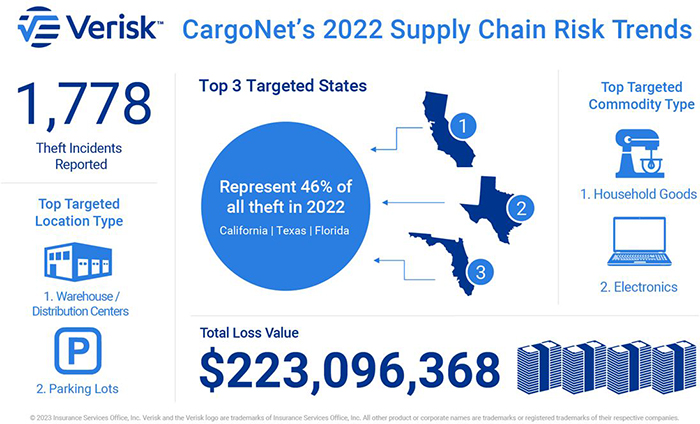An alarming rise in cargo theft is putting cargo owners and their insurers on edge. Thieves are also becoming more sophisticated in their maneuvers.

There were 1,778 “supply chain risk events” in the United States and Canada in 2022, a 15 percent increase from 2021, according to CargoNet, a commercial theft prevention and recovery service.
“The scarcity and cost fueled illicit market demand for hard-hit goods such as technology and food, particularly computer graphics cards and raw beef, poultry and pig,” according to the service. “Available capacity decreased in the final months of 2022, but theft remained a prominent threat.”
That said, the trends identified by CargoNet are supported by data from insurers. “We have our own cargo theft investigation team,” said Scott Cornell, Travelers’ transportation manager and crime and theft specialist.
“I use our internal numbers to validate CargoNet’s numbers, and yes, we’re seeing the same things on the street and listening to law enforcement and trucking companies. The increases are staggering. I don’t recall numbers like this one, and I’ve been at it for a while. Among my peer group, people are reaching out.”
From semi-trucks to tools and toys, thieves’ favorite steals
CargoNet data from 2022 indicates that events involving the theft of at least one heavy commercial vehicle such as a semi-truck or semi-trailer increased by 17% year over year, while events involving cargo theft increased by 20% Please note that a single event record could involve the theft of one or more vehicles or shipments. The average value of cargo stolen in one event was $214,104. CargoNet estimates that $223 million in cargo was stolen in all cargo theft events in 2022.
“Increases in theft activity around major intermodal hubs were significant,” the service detailed.
“California remained the top state for reported events in 2022, with thefts in the state up 41% year over year. Computer and green energy components were some of the most frequently stolen items in the ‘year, in part because California is a major logistics hub for these items.
Robberies in Georgia rose 34 percent, due in part to organized crime groups taking advantage of increased traffic at the Port of Savannah. Georgia shut down a state task force to investigate cargo theft in 2020.”
 Household items such as appliances and furniture were the most stolen goods in 2022. There was also a notable increase in thefts of tool and toy shipments. Household goods were closely followed by electronics.
Household items such as appliances and furniture were the most stolen goods in 2022. There was also a notable increase in thefts of tool and toy shipments. Household goods were closely followed by electronics.
Theft of computer electronics declined by 37% from 2021, but CargoNet noted that “theft of these items reached unprecedented highs in 2021 and theft was still high compared to the baseline. A moreover, the theft of TVs and other displays almost doubled from 2021.”
Fictitious cargo pickups travel the country
Dummy cargo pickups, involving both identity and cargo theft, increased in 2022, albeit from a small base. CargoNet recorded 96 more fictitious pickups in 2022 compared to the previous year, a 600% year-over-year increase.
The majority of fake cargo pickups occurred in California, 74% of the total, but the crime is spreading across the country. CargoNet has recently received reports of similar fictitious trucks in Washington state, New Jersey, Pennsylvania, Illinois, Texas and others. Shipments of solar modules, auto parts and vehicle maintenance products such as motor oil are most at risk, but the threat extends to most goods categories.
Theft trends are driven by the economy
While the rate of increase and the absolute numbers are striking, the direction of the trends is not, Cornell said.
“We saw it coming. The economy drives theft trends. In the 2008-2010 recession we saw a shift in theft from commodities to food and beverages. Commodities are in high demand, and for those in particular the security tends to be lower because the value of the goods is lower.”
These trends continued until about 2020, when home goods earned the dubious distinction of most stolen. “Thieves steal what they can sell,” Cornell explained.
“In 2021, electronics were back at the top of the list. Last year it was even between food, homeware and electronics. All were in high demand.”
The thieves’ strategy
As for the dire warnings about fictitious pickups, Cornell opposes that as a general term.
“There is direct theft, where the cargo is stolen from where it is, and there is strategic theft where the crime is arranged in advance. This can include identity theft or something like a double brokering scam. There have been spikes in those, and sometimes theft involves both, but they’re different things.”
In many incidents, thieves combine techniques to launder the cargo. They can pose as a trucking company to get a haul and then pose as a broker to arrange a transfer between docks. In some cases, the cargo is ultimately sold to a legitimate wholesaler or retailer.
The reason double brokering and false fronts are becoming more common is that these techniques put distance between the real thieves and the cargo. In many cases, legitimate companies are doing business in good faith, never knowing they are dealing with fraudulent counterparts or stolen goods.
“If the thieves are caught, or even just suspected, the electronic trail disappears,” Cornell said sadly.
“There’s also a perverse economy of scale, similar to email fraud and phishing. The theft ring may be running two dozen loads at once,” he said. “They only need a few to be successful. They’re throwing spaghetti at the wall hoping a few will stick.”
The other irony is that in most crimes, the fewer people involved, the better for the bad guys. In the case of fraudulent cargo transactions, the more counterparties involved, especially legitimate brokers or transport companies, the better camouflage for thieves.
Keep the horse in the barn, don’t chase it
Travelers’ cargo theft investigation team recovered $85 million in stolen goods for customers in 2022, Cornell said.
“As happy as we are about that, we’d rather keep the horse in the barn than have to chase it. It’s important for policyholders to understand that law enforcement has limited resources, so the question becomes what are they doing to mitigate the robbery
“Are they members of CargoNet or one of the other services? Do they have an insurer with capabilities and experience? Are they members of regional and global trade organizations such as the Transport and Asset Protection Association? Do they have a plan for what to do at 2am on a Saturday morning when the driver calls to say the trailer has been pulled from the truck stop? Cornell continued.
“Does everyone know the plan? Of course, call 9-1-1. so what? You can’t wait until Monday morning. The chances of recovery decrease the longer you wait.” &


